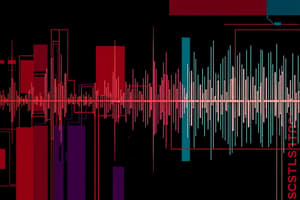Podcast
Questions and Answers
What is the ratio of total side band power to the total power in the modulated wave called?
What is the ratio of total side band power to the total power in the modulated wave called?
- Power spectral density
- Modulation index
- Sideband power ratio
- Efficiency of AM system (correct)
What type of device is a square law modulator?
What type of device is a square law modulator?
- Active device
- Passive device
- Non-linear device (correct)
- Linear device
What is the frequency of the dc component in the output of a square law modulator?
What is the frequency of the dc component in the output of a square law modulator?
- fc
- 2fc
- W
- 0 (correct)
What is the purpose of a band pass filter in a switching modulator?
What is the purpose of a band pass filter in a switching modulator?
What is the output of a switching modulator when c(t) is positive?
What is the output of a switching modulator when c(t) is positive?
What is the process of recovering the original information signal from the modulated wave called?
What is the process of recovering the original information signal from the modulated wave called?
What is the expression for the total input to a square law device in an AM wave?
What is the expression for the total input to a square law device in an AM wave?
What is the frequency range of the information signal in an AM wave?
What is the frequency range of the information signal in an AM wave?
What is the frequency range for AM in radio broadcasting?
What is the frequency range for AM in radio broadcasting?
What is the bandwidth of an AM wave?
What is the bandwidth of an AM wave?
What is the equation for an amplitude modulated signal?
What is the equation for an amplitude modulated signal?
What is the significance of 'ka' in amplitude modulation?
What is the significance of 'ka' in amplitude modulation?
What is the condition for the carrier frequency in amplitude modulation?
What is the condition for the carrier frequency in amplitude modulation?
What is the name of the modulation scheme where the amplitude of the carrier is varied linearly by the modulating signal?
What is the name of the modulation scheme where the amplitude of the carrier is varied linearly by the modulating signal?
What is the modulation index in amplitude modulation?
What is the modulation index in amplitude modulation?
What is the Fourier Transform of the amplitude modulated signal?
What is the Fourier Transform of the amplitude modulated signal?
Flashcards are hidden until you start studying
Study Notes
Amplitude Modulation (AM)
- Amplitude Modulation is the process of changing the amplitude of a high-frequency carrier signal in accordance with the amplitude of the modulating signal (information).
- The carrier amplitude is varied linearly by the modulating signal, which usually consists of a range of audio frequencies.
- The frequency of the carrier is not affected.
Applications of AM
- Radio broadcasting
- TV pictures (video)
- Facsimile transmission
Frequency Range and Bandwidth of AM
- Frequency range: 535 kHz – 1600 kHz
- Bandwidth: 10 kHz
Forms of Amplitude Modulation
- Conventional Amplitude Modulation (Full AM or Double Sideband Large carrier modulation (DSBLC) / Double Sideband Full Carrier (DSBFC))
- Double Sideband Suppressed carrier (DSBSC) modulation
- Single Sideband (SSB) modulation
- Vestigial Sideband (VSB) modulation
Time and Frequency Domain Description
- Amplitude modulated signal: s(t) = Ac [1 + kam(t)] cos(ωct)
- Fourier Transform: S(ω) = π Ac/2 (δ(ω − ωc) + δ(ω + ωc)) + kaAc/ 2 (M(ω − ωc) + M(ω + ωc))
Single Tone Modulation
- Modulating wave: m(t) = Acm cos(ωmt)
- Amplitude modulated signal: s(t) = Ac [1 + kam cos(ωmt)] cos(ωct)
Power Relations in AM Waves
- Ratio of total sideband power to total power in the modulated wave is called the efficiency of the AM system
Generation of AM Waves
- Two basic amplitude modulation principles:
- Square law modulation
- Switching modulator
Square Law Modulator
- Output of a non-linear device is not directly proportional to the input throughout the operation
- Input-Output relation: y(t) = a1x(t) + a2x^2(t)
- Square law device output: V0 = Vdc + Vm cos(ωmt)
Switching Modulator
- Total input for the diode: v1 = Ac cos(ωct) + m(t)
- When c(t) is positive, v2=v1, and when c(t) is negative, v2=0
- Switching response of the diode: v2 = v1 * s(t)
Detection of AM Waves
- Demodulation is the process of recovering the original message signal from the amplitude-modulated wave.
Studying That Suits You
Use AI to generate personalized quizzes and flashcards to suit your learning preferences.




